Chinese Mahjong [麻将 Má jiàng]
The game of mahjong (or mah-jongg) is another famous Chinese invention and export to the rest of the world.
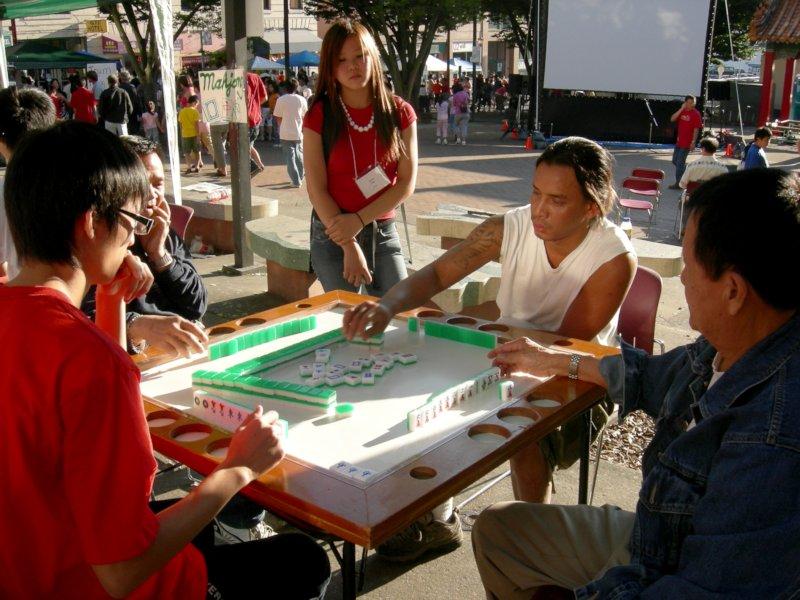
Mahjong is a game combining skill and chance vaguely similar to the card game of rummy ➚; the aim is to collect related groups of tiles, however the set of tiles and rules are a lot more complex than for cards. Like Chinese chess, Mahjong is often played in tea-houses and the clattering of tiles on tables is a frequently heard. The tiles were originally made of bone, bamboo or ivory but now are made from plastic. It is often played for small stakes.
Origins of Mahjong
In a search for evidence of an early use of the game, no definitive evidence pushes it back before the Taiping Rebellion but pastimes are rarely mentioned in old history books particularly when played by ordinary people rather than the scholarly elite. The oldest known sets come from about 1870 in the Ningbo region of Zhejiang, perhaps by Chen Yumen ➚ 陈鱼门 Chén Yúmén (1817-1878). On the other hand the mystique of an ancient game from the mysterious and exotic East was a major selling point, so it is possible it was invented more recently. Some people have said it goes back all the way to the time of Confucius but there is no evidence for this. The names normally used for the tiles suggest that the export to America came from the Guangdong (Canton) area.
It was originally known as 麻雀 Má què or ‘sparrow game’ in English and is still known by that name in southern China; while in the north it is 麻将 Má jiàng. Mah-Jongg, became a great craze as a parlor game in the 1920s when the US company Abercrombie & Fitch ➚ had great success in popularizing it; there were a number of trade marked versions of the game including ‘Pung Chow’ and ‘Game of Thousand Intelligences’.
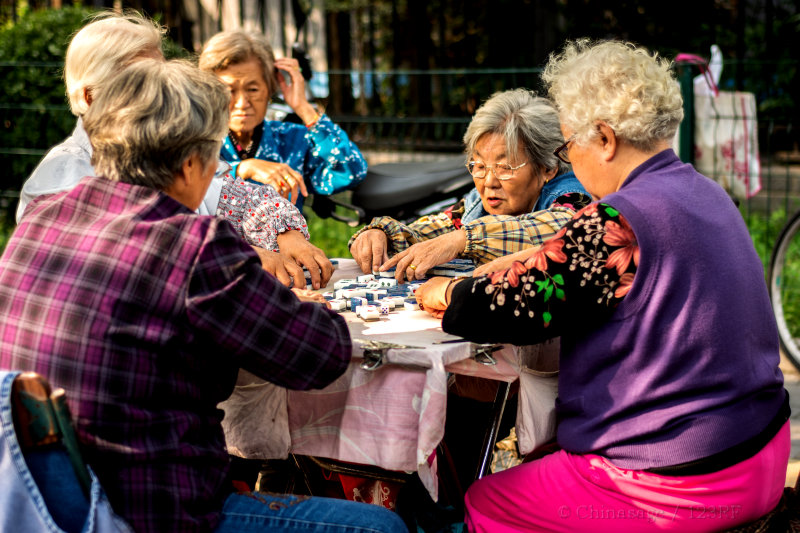
Mahjong set of tiles
A standard set has the following tiles:
Circles

The 36 Circle tiles are in four identical sets of 9 tiles with one to nine circles engraved on them. In Chinese they are 筒子 tǒng zi meaning ‘barrel’ or ‘tube shaped’, named after the circular coins with a hole in them that were the currency for many centuries. Circles are also known as ‘tans’ or ‘dots’.
Bamboos

The 36 Bamboo tiles are in four identical sets of 9 tiles with one to nine bamboo stems engraved on them. Bamboo in Chinese is 竹 zhú or else the 索子 suǒ zǐ ‘suit’ or ‘woven thread suit’. The ‘1’ is usually a picture of a bird; often a sparrow 麻雀 Má què by which the game is named in southern China. Bamboos are also known as ‘soks’ or ‘bams’.
Characters

The 36 Number tiles are in four identical sets of 9 tiles with the Chinese characters for the numbers 1 to 9 engraved on them. On many sets the character for 万 wàn萬 ‘10,000 or numerous’ is underneath each Chinese number. They are also known as ‘wans’ or ‘craks’. Old Chinese coins were often strung together in hundreds, a hundred of such strings represented a large number of coins - 10,000 and is often used to mean ‘countless’ or ‘beyond measure’.
Serials
The circles, bamboos and numbers form the 序数牌 Xù shù pái ‘serials’ and only these tiles can form runs or ‘chows’ (2,3,4; 5,6,7 and so on).
The ones and nines at the ends of the sequence are called ‘terminals’ or 纯幺九 Chún yāo jiǔ. The terminals can give higher scores and so need special attention.
Winds

There are 16 Wind tiles in four identical sets of four tiles for each of four wind directions. Collectively known as the 风牌 Fēng pái, they are always listed in this order: 东 east, 南 south, 西 west and 北 north.
Dragons
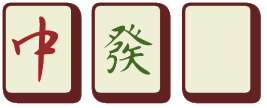
There are 12 Dragon tiles in four identical sets of three tiles: red; green and white dragons. Collectively they are also known as the 三元牌 Sān yuán pái three scholars, the change from scholars to dragons may have happened when the game was exported to America. 红中 Hóng zhōng (Traditional 紅中 ) Red dragon or Red center 青发 Qīng fā (Traditional 青發 ) Green dragon or Green fortune 白板 Bái bǎn Blank or White dragon or White board. The white dragon is often a completely blank tile or sometimes just an empty frame.
Honor tiles
The 12 dragons and 16 winds together are called 番子 Fān zǐ ‘the Honor’ tiles.
Seasonal Flowers

There are four Flower bonus tiles which may have an Arabic number (1-4) on them as well as a flower: Plum blossom 梅 méi, Orchid 兰 lán (Traditional 蘭), Bamboo 竹 zhú and Chrysanthemum 菊 jú. Each flower represents a season - winter, spring , summer and autumn respectively. These are optional tiles collectively called 花牌 Huā pái ‘blue flowers’ and do not play a full part in the game - they add a bonus to the score.
Seasons

The four Season bonus tiles in Mahjong, which may have an Arabic number (1-4) are often engraved as a picture representing spring, summer, autumn and winter, sometimes also with the Chinese character for the season. They are also known as the 红牌 hóng pái ‘red flowers’ and like the flower tiles give a bonus to the score rather than play a full part in the game. 春 chūn Spring, 夏 xià Summer, 秋 qiū Autumn and 冬 dōng Winter
Full Mahjong Set
All these groups together gives a total of: 36 circles + 36 bamboos + 36 characters + 16 winds + 12 dragons + 4 flowers + 4 seasons = 144 tiles or 牌 páis. The original Chinese game did not include the flowers and seasons so the total was then 136. However, some American sets also have 8 joker tiles that add a little further complication. In Singapore there are sets where there are some extra pairs e.g. cat and rat.
Dealing the tiles
The game usually has four players who take it in turns to pick up tiles to try to form sets. The first task is to shuffle the tiles, all players take part by moving them around with both hands, with the faces of the tiles downward on the table. Then the wall is built. The square 牌墙 pái qiáng wall is 18 tiles wide and 2 tiles high (face down) on all four sides. The dealer then throws three dice to determine where to start dealing out the tiles. The score (1-18) determines which wall and part (quarter) of the wall forms the start point for dealing. The dealer then takes four tiles from the left of this position and the other players continuing taking a set of four until they each have 12 tiles (in 3 groups of 4) moving clockwise around the table. Each player then finally takes a single extra tile in turn to make a total of 13 tiles. A quicker version just takes the tiles from the corner of the dealer's portion of wall.
At this stage if any player has a ‘flower’ or ‘season’ tile these are set aside (used only for scoring bonuses) and an extra tile is picked up to replace them.
All players are associated with a compass direction: East - South - West - North winds. After each round the designation of ‘dealer’ or East wind moves around one place anti-clockwise. The game is complete when all four players have been dealer. Whenever the dealer wins a hand or if there is no winner (a draw) an extra hand is played.
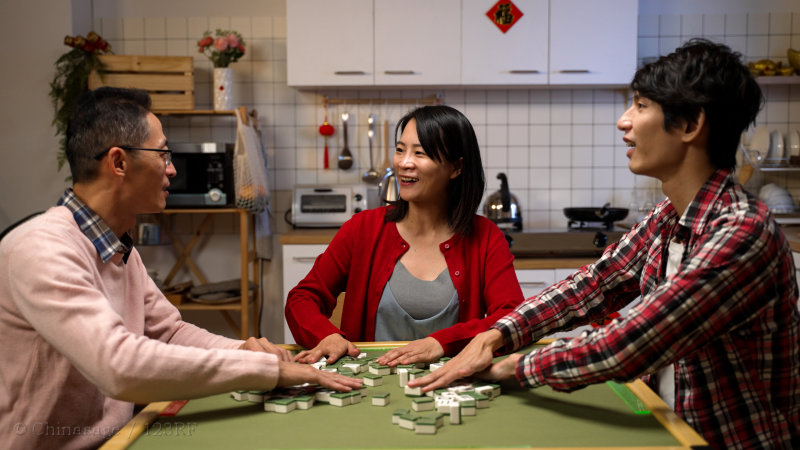
Playing Mahjong
East starts the game by discarding a tile. Who is initially east is usually decided by throwing a die (highest number wins) or else by drawing the ‘East wind’ from the set of four wind tiles. The dealer who casts the dice and first picks up tiles is called ‘jonga’ (庄家 zhuāng jiā). If the dealer has a complete ‘winning’ hand this can be announced and put down, otherwise he chooses a tile and discards it into the central area - the 牌池 pái chí ‘floor’ between the four walls of the square. Play now moves anti-clockwise to the dealer's right (South). Each player can then take from either the wall or the pool of discarded tiles in the middle. A player can steal or ‘meld’ by picking up a discarded tile rather than one from the wall. This can interrupt the order of play, as any player can do this, the player who picks up the discarded tile must put down the ‘meld’ (which can not be an ‘eye’ [see below] unless it completes a mahjong). The play resumes to this player's right. Each player follows the same pattern : take a tile, optionally puts down completed groups and then discard a tile. The order of play passes counter-clockwise. A player should always have 13 tiles in total. Just as in the setup, if a ‘flower’ or ‘season’ tile is picked up from the wall this is immediately put aside and another tile taken from the wall.
The aim is to collect groups and runs of tiles. A winning hand is made up of four groups of related tiles. The complexity comes from the large range of possible sets and the skill of working out what other players are collecting - on the basis of what discards they pick-up or the tiles they discard.
For a more detailed account and diagrams explaining the playing of Mahjong please see Sloperama page ➚.
Special terms are used for the name of sets of related tiles or pai:
| Pair | Duì 对 . Two identical tiles of any kind. e.g. 4 circles and 4 circles. 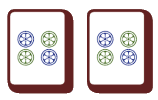 |
| Chow | Shùn zǐ 顺子 or chī 吃 is a run of three serials in order. For example 4, 5 and 6 of circles. 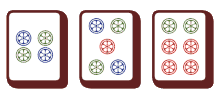 |
| Pung or Pong | Pèng 碰 or kè zǐ 刻子 is a set of three identical tiles of any kind. For example 7, 7 and 7 of bamboo.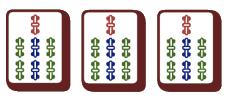 |
| Kong | Gàng 杠 is a set of four identical tiles of any kind. For example all 4 east wind tiles.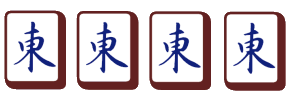 |
| Eye | Yǎn 眼 is a pair of tiles in a winning hand that is independent of the other sets so a pair of 4 circles would be an eye only if 4's and circles do not feature in the other sets. |
The rules associated with forming a complete group called a ‘Kong’ are different to the other groups. A player can choose to declare a Kong and lay it down but with only two tiles exposed. If a player makes a Kong using a discarded tile the discarded tile is placed on top of the other three. All this is to help the other players work out what other players might be collecting. A player can also add to their existing Pung with a picked up (but not discarded) tile. The fourth tile forming the Kong is not counted, the player picks up an extra tile from the wall and discards one.
When a player reckons they have a winning hand he/she calls ‘Mahjong’ and the scores for all the hands are counted up, the person calling ‘Mahjong’ might not have the highest score and so may not have won the hand. A winning hand must score at least a minimum number of points. However if the game reaches the stage that there are no more tiles left to pick up from the wall and no-one has claimed ‘Mahjong’ then it is a draw and a new game is started.
Scoring
Scoring Mahjong is complicated because certain combinations of tiles are given important bonuses and there are several conventions for scoring. This is rather like all the different bidding conventions in the game of bridge ➚. For example there are special bonuses for such things as Seven Pairs; Thirteen Orphans; Heavenly Gates; The Coward; All Pungs; All Chows. The flower and season tiles picked up during the round give a bonus to the score. There are different scoring conventions in China (Chinese Classical or CC), Shanghai (New style), Singapore, Hong Kong (HKOS), UK, America so this must be agreed ahead of the game.